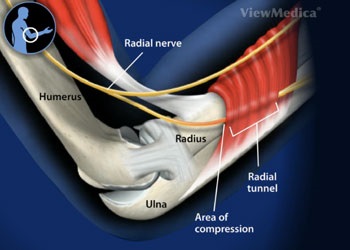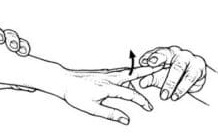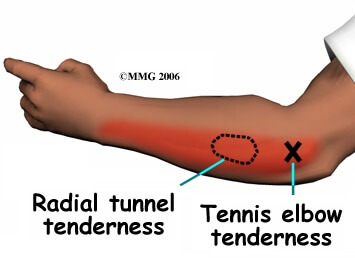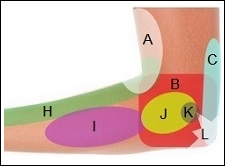- Home
- Elbow Pain Diagnosis
- Radial Tunnel Syndrome
Radial Tunnel Syndrome
Written By: Chloe Wilson BSc (Hons) Physiotherapy
Reviewed By: SPE Medical Review Board

Radial tunnel syndrome causes pain and weakness in the forearm and can affect elbow, wrist and hand function.
It is caused by repetitive pressure on one of the nerves in the forearm as it passes through the radial tunnel, a small channel between the soft tissues and underlying bone.
Radial tunnel syndrome accounts for approximately 5% of cases of lateral elbow pain and is often mis-diagnosed as lateral epicondylitis aka tennis elbow.
Most cases will resolve in a few weeks with correct radial tunnel syndrome treatment, but in more stubborn cases, surgery may be required.
Radial tunnel syndrome may also be referred to as supinator syndrome, posterior interosseous nerve syndrome or radial nerve entrapment.
Here we will look at what radial tunnel syndrome is, the common causes and symptoms, how it is diagnosed and the best radial tunnel syndrome treatment options.
What Is Radial Tunnel Syndrome?
Radial tunnel syndrome is where there is compression of one of the nerves in the forearm.
There are three main nerves in the forearm which originate in the neck, travel down the arm all the way to the hand, controlling movement and sensation in the elbow, forearm, wrist and hand:
- Radial Nerve: travels down the outer forearm to the back of the hand, thumb and index finger
- Median Nerve: travels down the middle of the forearm to the palm of the hand, thumb and middle three fingers
- Ulna Nerve: travels down the inner forearm to the side of the hand, ring and little fingers
In radial tunnel syndrome there is compression of the radial nerve. The radial nerve runs down the back of the upper arm, controlling the tricep muscle, and spirals outwards, crossing the outer side of the elbow. Approximately 1.3cm below the elbow, it divides into two, a superficial and deep branch. Radial tunnel syndrome affects the deep branch.

The deep radial nerve branch travels down the back of the forearm and passes through the radial tunnel.
The radial tunnel is an area around 4cm wide between the supinator muscle and the forearm bone (radius).
As the deep nerve exits the supinator muscle, it becomes known as the posterior interosseous nerve.
Radial tunnel syndrome refers to compression of the radial nerve anywhere along the radial tunnel. There are five possible locations along the radial tunnel where the nerve may get pinched resulting in radial nerve entrapment:
- Arcade Of Frohse: an arch formed by the border of the supinator muscle nearest to the elbow. Compression here is often referred to as Supinator Syndrome.
- Distal Border Of Supinator: the far edge of the supinator muscle, furthest from the elbow where the nerve emerges as the posterior interosseous nerve. Compression here is referred to as posterior interosseous nerve syndrome.
- Leash Of Henry: a fan of vessels arising from the radial recurrent artery
- Fibrous Adhesions: between the brachialis and brachioradialis muscles
- Extensor Carpi Radialis Brevis: the fibrous edge of the ECRB muscle
Radial tunnel syndrome most commonly occurs as the nerve enters the radial tunnel at the Arcade of Frohse. Posterior interosseous nerve syndrome, where the compression occurs as the nerve leaves the radial tunnel, is the second most common site for radial tunnel syndrome.
What Causes Radial Tunnel Syndrome?
Radial tunnel syndrome is caused by pressure on the radial nerve as it passes through the radial tunnel. This pressure is typically caused by irritation and fibrosis of the structures in and around the tunnel which leads to localised inflammation. This reduces the space in the radial tunnel causing pinching of the nerve which leads to radial tunnel syndrome.
Radial tunnel syndrome is typically caused by:
- Repetitive Forearm Movements: particularly gripping and twisting movements e.g. using a screwdriver, forceful pushing and pulling, or heavy lifting
- Manual Labor: e.g. factory work or carpentry
- Sports: that involve lots of throwing e.g. football and baseball
- Direct Blow: to the outside of the elbow e.g. fall
The most common cause of radial tunnel syndrome is thought to be repetitive twisting movements of the forearm known as pronation and supination.
Other potential risk factors for developing radial tunnel syndrome include:
- Shoulder/Arm Pathologies: e.g. shoulder instability, osteoarthritis, CTS, elbow fracture/dislocation
- Age: most common between ages of 30-50
- Gender: more common in women
- Hand Dominance: typically affects the dominant hand. Very rarely bilateral
Radial Tunnel Syndrome Symptoms
Typical symptoms of radial tunnel syndrome are:
- Pain & Tenderness: Over the outer forearm, at least 3cm below the elbow. People often describe it as a nagging ache or a burning pain
- Worse With Activity: pain gets worse with gripping, lifting, forearm rotation or finger extension activities
- Night Pain: pain may be worse at night and interfere with sleep
- Weakness: gradual weakening of forearm and wrist muscles affecting grip strength and hand control. Weakness is usually secondary to pain with radial tunnel syndrome
- Normal Skin Sensation: sensation is typically unaffected as the sensory part of the radial branches off before reaching the radial tunnel i.e. no increased/decreased sensitivity to touch, tingling or numbness
Tests For Radial Tunnel Syndrome
In most cases, your primary care physician/GP will be able to diagnose radial tunnel syndrome. They will start by taking a full history to find out how and when the pain started, your current symptoms, aggravating and easing factors, your work and hobbies, and any other related injuries.
Your doctor will then carry out a physical examination looking at the movement and strength in your arm, wrist and hand, and they will palpate the area. There are two specific tests for radial tunnel syndrome that they may also use to aid diagnosis:

- Maudsley’s Test: With this test for radial tunnel syndrome, your doctor will get you to perform middle finger extension against resistance (elbow extended, wrist in neutral). Pain in the forearm indicates radial tunnel syndrome, whereas pain at the elbow indicates lateral epicondylitis
- Resisted Supination: In the resisted supination test for radial tunnel syndrome your doctor will ask you to turn your forearm from a palm down to palm up position against resistance. Forearm pain indicates a positive test for supinator syndrome
They may also send you for further tests for radial tunnel syndrome such as:
- X-rays: of the elbow to check for any bony abnormalities
- MRI: of the neck (cervical spine) to check for any nerve root compression
- EMG: electromyography looks at how the muscles are working
- Nerve Conduction Studies: to look for any nerve damage with radial nerve entrapment
These tests are usually done to rule out other conditions rather than to specifically diagnose radial tunnel syndrome.
Differential Diagnosis
Radial tunnel syndrome is not the only possible cause of outer forearm pain.

Things to look for that would indicate a different problem are:
- Elbow Pain: if there is pain over the lateral epicondyle (the hard, bony lump on the outer elbow) which may or may not radiate down the forearm to the wrist, it is more likely to be Tennis Elbow.
- Altered Sensation: if there is any hypo or hypersensitivity, tingling or numbness in the forearm, it is more likely due to nerve compression higher up the arm or in the neck rather than radial tunnel syndrome.
- Hand Symptoms: if the pain extends into the back of your hand, thumb or index finger, it is more likely to be brachioradialis pain or radial wrist pain. If there is numbness in the fingers and thumb, it is most likely carpal tunnel syndrome.
Visit the forearm pain diagnosis section to find out more.
Radial Tunnel Syndrome Treatment
Most cases of radial tunnel syndrome can be treated without the need for surgery.
Conservative radial tunnel syndrome treatment may include:
- Rest: from aggravating activities – anything that involves repetitive forearm twisting and wrist movements. A good guide here is if it hurts, don’t do it!
- Injections: where mixture of steroid and local anesthetic is injected through the radial tunnel for relief of pain and inflammation
- Medication: Over-the-counter medication to reduce pain and inflammation e.g. paracetamol and ibuprofen
- Splint: wearing a wrist splint and/or elbow splint to reduce forearm movement can really help to give the soft tissues time to heal
- Physical Therapy: stretching exercises help to combat muscle tightness and strengthening exercises help to combat muscle weakness. They may also carry out ultrasound, joint mobilisations and teach you neural stretching exercises if indicated
If your symptoms fail to settle after 6 months of conservative radial tunnel syndrome treatment, then your doctor may recommend radial tunnel release surgery.
#CommissionsEarned from Amazon on qualifying purchases
Surgery
Radial tunnel release surgery, also known as radial tunnel syndrome decompression, aims to reduce the pressure on the radial nerve by widening the radial tunnel.
An incision is made along the outer elbow and the surgeon will identify any areas of radial nerve compression. Small cuts will be made in these areas to decompress the nerve and expand the radial tunnel. The incision is then stitched back together and in most cases you can go home later that day.
Following decompression surgery you will be given a splint to wear for a few days after which you will have a course of physical therapy to regain the strength, mobility and control in your elbow, forearm and hand.
Full recovery usually takes around 3-6 months. Radial tunnel release surgery is successful in around 60-70% of cases, but some people do have problems with ongoing pain.
History Of Radial Tunnel Syndrome
Radial tunnel syndrome was first reported in 1956 by Michelle & Kruger at which point it was known as “radial pronator syndrome”.
In 1972, a link was found between lateral forearm pain and compression of the posterior interosseous nerve and it became known as “resistant tennis elbow with nerve entrapment” (Roles & Maudsley).
The term Radial Tunnel Syndrome was first introduced by Eversmann in 1993 who described the link between the supinator muscle and nerve compression through the radial tunnel.
Summary
- Radial tunnel syndrome is caused by pinching of the radial nerve just below the elbow as it travels through the radial tunnel.
- It typically develops due to repetitive forearm twisting and gripping movements.
- Radial nerve compression can occur anywhere along the course of the radial tunnel but is most common where the nerve enters the tunnel (arcade of Frohse) or leaves the tunnel (posterior interosseous nerve syndrome).
- The main symptoms of radial tunnel syndrome are pain on the back of the forearm at least 3cm below the elbow. Pain may be accompanied by weakness but there is rarely any altered sensation.
- Radial tunnel syndrome treatment involves a combination of rest, medication, exercises and injections, but if symptoms fail to improve then radial tunnel release surgery may be advised.
- Radial tunnel syndrome is often misdiagnosed as lateral epicondylitis – the location of pain is the main differentiating factor.
- Radial tunnel syndrome may also be referred to as supinator syndrome, posterior interosseous nerve syndrome and radial nerve entrapment.
Related Articles
Page Last Updated: February 4th, 2025
Next Review Due: February 4th, 2027


